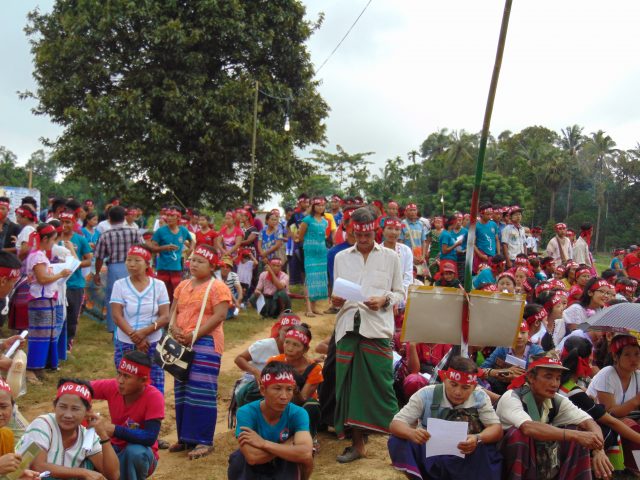Our Hunger for Energy

Today, the 9th of August, marks the International Day of the World’s Indigenous Peoples. On this day Indigenous communities and civil society groups from the Tanintharyi River Basin are releasing two new reports that present the interdependence between indigenous communities, the Tanintharyi River and the surrounding biodiversity, and the new challenges posed by a host of proposed hydropower dams.
Beyond the River: Overcoming Challenges with Indigenous Ecological Knowledge by TRIPNET, and Blocking a Bloodline: Communities Along the Tanintharyi River Fear the Impacts of Large-Scale Dams by Candle Light, Southern Youth and Tarkapaw together call for the territories, local knowledge and customary practices of indigenous communities to be recognised, and for proposals for large-dams to be halted.
The profiles of the 115 fish and aquatic species presented in Beyond the River: Overcoming Challenges with Indigenous Ecological Knowledge are the result of local knowledge-based research conducted over four years by indigenous Karen people living in the Tanintharyi River basin. Local knowledge-based research is a community-led research process whereby communities document their ecological knowledge and traditional natural resource management practices. TRIPNET has been facilitating local knowledge-based research initiatives with communities in the Tanintharyi River basin since 2014 as a strategy for community empowerment.
“Local people are skilled at natural resource management and possess intimate knowledge of the local biodiversity. The research findings in this report reveal the strong interconnections local communities have with the Tanintharyi River” says TRIPNET Project Coordinator Saw Albert.
It is important that the deep ecological knowledge of the people living in the Tanintharyi River basin is recognized and used in conservation initiatives and decision-making regarding hydropower development in the basin. Beyond the River illustrates how the rich biodiversity of the Tanintharyi River is crucial for local people’s livelihoods, and how both would be irreparably damaged by hydropower dam construction in the basin.
“Indigenous people are protecting the river and natural resources, so a platform needed to be created to show their motivation and share their success doing community-based conservation,” says TRIPNET Director Saw Frankie Abreu.
The implementation of this participatory local knowledge-based research process has had impacts beyond the findings presented in Beyond the River. This community-led research process directly contributed to the establishment of a growing network of Community Protected Fish Conservation Zones across Tanintharyi Region. These community managed conservation initiatives are examples of Indigenous and Community Conserved Areas (ICCAs) in Myanmar.
“We local people must be included in all decision-making regarding our territories because we have the knowledge and ability to manage our own resources” said U Ye Aung, a member of Rays of Kamoethway Indigenous People and Nature speaking at the report launch, adding “our efforts to protect fish species contribute to the protection of the entire ecosystem around the Tanintharyi River.”
The devastating impacts of a proposed 1,040 Mega Watt dam on the Tanintharyi River are illustrated in “Blocking a Bloodline: Indigenous Communities Along the Tanintharyi River Fear the Impact of Large-Scale Dams” . This dam proposal put forward by Thai-owned GMS company along with 17 other dam proposals on the river have been developed with out the Free, Prior and Informed Consent of Indigenous communities, and threaten to destroy their primary source of water, food and transportation.
“We have found that the construction of this dam could displace up to 7,000 people in 32 villages along upstream reaches of the Tanintharyi River” said Naw Paw Say Wah, director of Candle Light. “This dam will also have serious impacts on the lives and livelihoods of over 23,000 people who live downstream of the proposed project”.
The report, based on surveys conducted with over 1,200 people along the Tanintharyi River, highlights the importance of the river for community livelihoods, access to water, transportation and cultural practices, and presents the impacts dam proposals would have on the lives of indigenous communities, forests and biodiversity, and the future of peace and stability in the region.
“The river is the lifeblood for us indigenous people in Tanintharyi Region. We depend on it for our food, our water, and our transportation. Without it we will not be able to survive” said Saw Than Naing from Tharabwe East Village. “If large scale dam projects go ahead in our territories then our livelihoods, our cultures, our history and our identity will be erased” he said.
Myat Su – 09960939600 (TRIPNET)
Saw Sarboe – 09773962030 (TRIPNET)
Naw Paw Say Wah – 09250244188 (Candle Light)
Saw Than Naign– 092616120141 Tharabwe East, Kaing Mya Thit Zar Committee

